John Bengtson's Blog, page 10
March 28, 2020
Keaton’s The Cameraman on the Santa Monica Pier
[image error]For their first date in The Cameraman (1928) Buster Keaton and Marceline Day strip down and go swimming in a public pool, because, why not? As reported in my book Silent Echoes, their natatorium adventure was filmed [image error]inside the Venice Plunge (1908-1945), once a huge beachside tourist attraction. There’s a keen sense of time-travel to the interior pool scenes, the shiplap walls, the tile floors, you can almost smell the chlorine. LAPL.
When it’s time to return home Buster and Marceline fail to catch an overcrowded bus, not in Venice where the plunge was located, but running down the Santa Monica Pier. The downhill slope in the background was the initial clue.
Click to enlarge – while Keaton had filmed at other amusement piers, this marked Santa Monica’s first appearance with Buster. Huntington Digital Library. Buster later filmed scenes from Spite Marriage (1929) beside the Hotel Carmel at 1451 Second Street in Santa Monica (read more HERE).
Click to enlarge – after missing the bus, Buster’s rival for Marceline’s affection, smooth-talking Harold Goodwin happens to drive by, and offers them a ride home. Notice the giant La Monica Ballroom in the foreground. Inset above, Buster helps Harold with his car roof. Huntington Digital Library.
As they adjust the roof, the entrance awning to the landmark La Monica Ballroom (1924- 1963) appears at back. Situated on the far end of the pier, the La Monica was once the largest dance hall on the west coast, with a capacity of 5,000. LAPL.
Of course there’s only room for Buster at back in the rumble seat. As soon as they take off it begins to pour, completely drenching Buster by the time they return to town. As shown above, they drive east along the pier past the Bowling-Billiard building and the Loof Carousel-Hippodrome, both still standing. USC Digital Library.
I was stunned to discover this elaborate sequence was filmed completely on the narrow pier. The complex traveling shot with Buster being drenched required mobile overhead rain sprinklers keeping pace with the car and camera car, and plays onscreen as if staged on a local street rather than 20 feet above the water. The logistics seem staggering.
[image error]
You can read how Buster and Marceline begin their date in Manhattan, with Buster leaving his place at 201 E 52nd Street, and departing her place at 20 W 58th Street, at these URL posts.
Please help support naming the Chaplin Keaton Lloyd alley in Hollywood by posting a review on Google Maps. Prototype alley sign design by noted Dutch graphic artist – Piet Schreuders. Download a 4-page brochure about the alley HERE.
March 15, 2020
Three Good Fellows – Harold Lloyd, Doug MacLean, and Ben Model
[image error]Musician Ben Model is a silent film super-hero. Aside from his duties as resident accompanist for MoMA in New York, and performing at silent screenings around the county, his indie Undercrank Productions has released over 20 rare silent movie DVDs, including the delightful Alice Howell Collection. I first learned about Alice, and was to able to enjoy some of her films, thanks to Ben. (This post HERE features a few early Hollywood scenes from her films.)
[image error]
When Good Fellows Get Together
Ben’s latest release The Douglas MacLean Collection is a revelation. I had never heard of Doug before Ben shared him with us. As Ben describes in his blog, MacLean made light comedy features before Chaplin, Keaton, and Lloyd switched to feature productions, at the same time Douglas Fairbanks was dropping the light comedy genre to make swashbucklers instead. The collection includes MacLean’s features One a Minute (1921) and Bell Boy 13 (1923), together with a 1920 promotional film portraying the Thomas Ince Studio in Culver City, MacLean’s producer. These films are packed with amazing images and locations, enough for several lengthy posts. But we’ll start with the overlap between MacLean and Harold Lloyd.
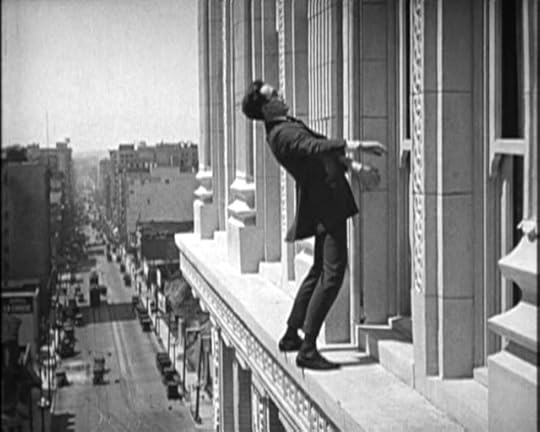

To begin, the March 1921 edition of Picture-Play magazine posted above reports Doug visiting Harold Lloyd, and how they are a couple of jolly good fellows. Here they are clearly setting on the Hill Street stunt set built for Harold’s 1920 production High and Dizzy.



Doug must have picked up a few tips from Harold, as his 1923 Bell Boy 13 (upper left) also has a brief stunt scene filmed above the Hill Street Tunnel. A similar set for The Terror Trail (1921) (center and right) reveals the secret.



Next, Doug’s “home town” train station scenes from One a Minute upper left overlaps with Harold’s home town train scenes in Girl Shy (1924) lower left. Paul Ayers, attorney, historian, and hiking trail expert, who has shared many remarkable location discoveries over the years, identified this as the Hynes Union Pacific depot, later destroyed by fire in 1946.

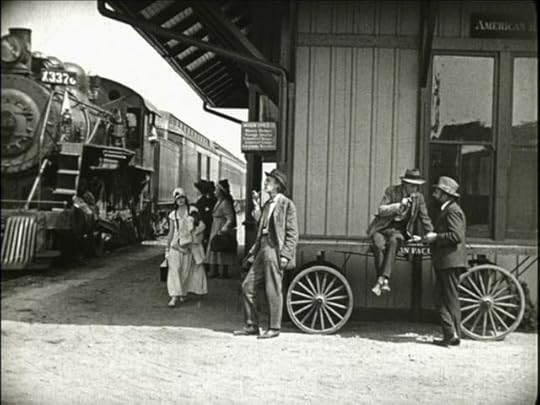
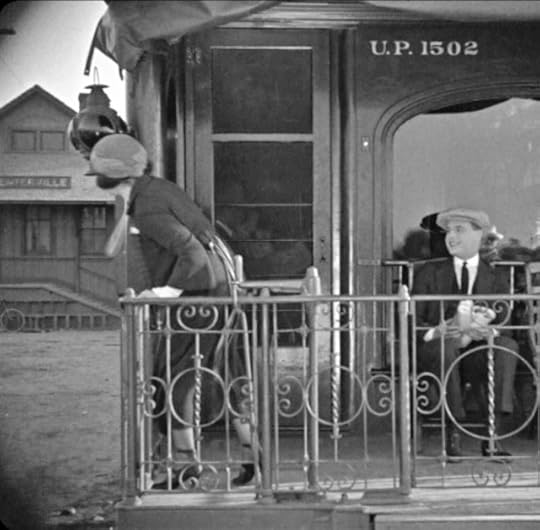
Paul studied many clues confirming the site, including the scene upper left where the partially legible “HYNES” depot sign appears with Marian De Beck (“Marion” in the film credits) during One a Minute. Other clues, looking north during Girl Shy, upper middle, Paul noticed a bit of “uniON PACIfic” between the men sitting on the baggage cart beside Jobyna Ralston, while the two-shot of Doug and Marian looking south, upper right, was filmed on a “U.P. (Union Pacific) 1502” passenger car.


Looking west from the Hynes depot, matching views from One a Minute, 1921, left, and Girl Shy, 1924, right, both show the same modest home with a left-facing porch. The house in the Girl Shy frame closer to the depot was built after Doug filmed in 1921.


This 1925 map shows the Hynes depot (red box), and the dozen or so buildings and homes comprising the tiny town about 11 miles north of Long Beach. In Girl Shy, above right, Richard Daniels cheers on Harold as he races west to catch the train departing south from the Hynes Depot (yellow oval). The small neighboring communities of Hynes, and Clearwater to the north, were once the dairy capital of Southern California. They unified under the city name Paramount in 1948.


Switching locales, in One a Minute Doug runs beside the Palms Garage on the SE corner of Motor Ave. and National Blvd., the same view east down National as the cops chase Harold for being a suspected bootlegger in Girl Shy, above right. Situated in Palms, close to the Hal Roach Studios in Culver City, this corner garage appears in many Roach productions, especially the silent Our Gang shorts.
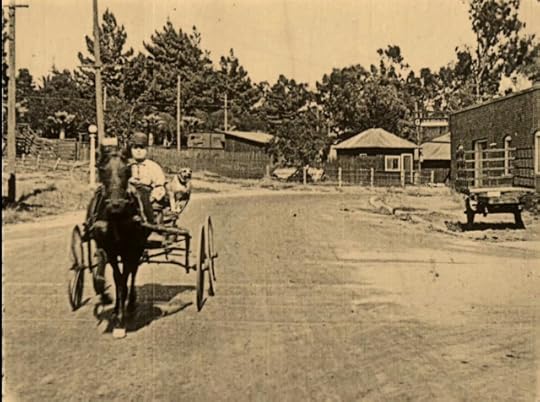

Above left, a matching view east down National with Roscoe Arbuckle in The Hayseed (1919). Roscoe and co-star Buster Keaton filmed at the intersection of Motor and National years before it became a common setting in Hal Roach comedies. Remarkably the corner Palms Garage building remains standing today.



In closing, this time Doug’s Bell Boy 13 lower right overlaps with Harold’s Girl Shy, lower left, with scenes staged at the former Southern Pacific Depot at 5th and Central downtown. A popular filming site, the depot also appears with Harold in Just Neighbors (1919), Douglas Fairbanks in When The Clouds Roll By (1919), and Stan Laurel in Mother’s Joy (1923), as explained in detail HERE. USC Digital Library.
HAROLD LLOYD images and the names of Mr. Lloyd’s films are all trademarks and/or service marks of Harold Lloyd Entertainment Inc. Images and movie frame images reproduced courtesy of The Harold Lloyd Trust and Harold Lloyd Entertainment Inc.
Be sure to check out The Douglas MacLean Collection and all of Ben’s other DVD releases. Thank you Ben!
Please help support naming the Chaplin Keaton Lloyd alley in Hollywood by posting a review on Google Maps. Prototype alley sign design by noted Dutch graphic artist – Piet Schreuders. Download a 4-page brochure about the alley HERE.
March 1, 2020
Buster, Harold, and Stymie at the Venice Pier
A prior post explains Buster Keaton and Orson Welles crossed paths filming in Venice, California. But what about Buster and Our Gang superstar Stymie Beard?
Above Buster in The High Sign (1920) and Orson directing A Touch of Evil (1958). Below – Buster and Matthew “Stymie” Beard.
During the 1933 Our Gang comedy Fish Hooky, the gang’s plan to skip school in order to go fishing backfires when they discover their teacher has arranged to take the class to the amusement park that day, entirely for free. When they catch up with her at the beach, she shoos them away, warning them that the truant officer is after them.


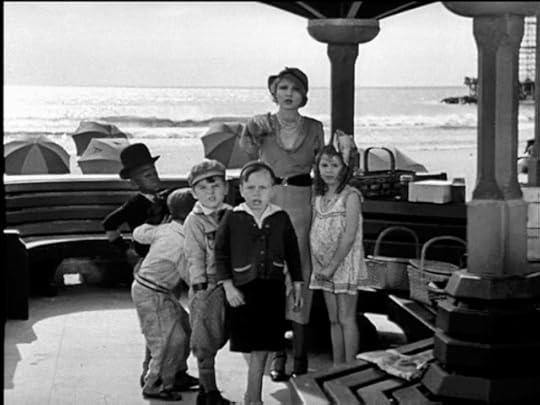
[image error]Above, Our Gang alumna Mary Kornman plays the teacher, and her Our Gang co-star Mickey Daniels (left) plays the truant officer, seen here coyly chatting with Spanky McFarland, Dickie Moore, and Stymie Beard, not yet revealing to them his sinister occupation.



When Mary shoos the gang away, directly above her hand is the entrance to the Nautilus Apartments that once stood at 1811 Ocean Front Walk in Venice, just south of the pier. The red box marks the “Nautilus” signing hanging over the entrance, both in 1933, left, and in Keaton’s 1920 film, center. Before this same entrance is where Buster flashes the “fooled you” high sign to the audience when he does not slip on a banana peel dropped on the sidewalk.
Click to enlarge – above, this 1920 aerial view shows the Nautilus Apartment (yellow star) and the future picnic table site (red box), south of the amusement park pier that would burn down later in 1920, only to be quickly rebuilt. Marc Wanamaker – Bison Archives.
Above, a January 9, 1933 ground level view of the Our Gang picnic site (red box) and the Nautilus Apartment (yellow star), by Anton Wagner. California Historical Society.
What’s more amazing, while writing this post I came to realize that the Nautilus Apartment building is still standing! I checked the online building permits for 1811 Ocean Front in Venice, and while undergoing numerous alterations and upgrades over the years, it appears the core building remains.



Fish Hooky has ties to another silent comedy, Harold Lloyd’s Grandma’s Boy (1922). At left triumphant Harold stands over the vanquished bully on the Higuera Bridge over Ballona Creek, due east of the so-called Forty Acres movie studio backlot in Culver City. The same bridge is where Joe Cobb and Allen “Farina” Hoskins persuade the gang to cut school to go fishing instead. Notice the matching farm house in the left and right images.
[image error]
This view east shows part of the Forty Acres movie set backlot at left, the Higuera Bridge over Ballona Creek, and the same lone farm house to the right. Marc Wanamaker – Bison Archives.
Please help support naming the Chaplin Keaton Lloyd alley in Hollywood by posting a review on Google Maps. Prototype alley sign design by noted Dutch graphic artist – Piet Schreuders. Download a 4-page brochure about the alley HERE.
Below, the Nautilus Apartment now “Muscle Beach” building.
February 15, 2020
Mary Pickford, the Talmadge Sisters, and Buster Keaton at the Brunton Studio
[image error]The Hoodlum (1919), Mary Pickford’s second independent production, followed her triumphant debut self-production Daddy Long Legs (1919). DDL brims with so much Los Angeles history and locations it took two lengthy posts to cover them all, HERE and HERE, and was noteworthy in particular for filming the orphanage exteriors at the abandoned Occidental College Hall of Letters where Charlie Chaplin later filmed The Kid (1921).
[image error]In The Hoodlum Mary plays a spoiled rich girl living with her wealthy grandfather in a 5th Avenue mansion. Her life is transformed when her estranged sociologist father visits from England to study New York slums for his book, and she chooses to live with him there. After a rough start (she arrives in a chauffeured limousine, above), Mary learns to navigate slum life, empathize with the less fortunate, and falls for a young man played by Kenneth Harlan, falsely imprisoned due to her grandfather’s corruption.
[image error]As Kevin Brownlow reports in his beautifully illustrated coffee table book Mary Pickford Rediscovered, the critics were duly impressed that the East Side slum scenes were actually filmed in California. Quoting Brownlow “[a]rt director Max Parker built a splendidly convincing section of New York at the Brunton Studios (later Paramount). His work was so extraordinary that he ought to be better known. He changed his style radically in the 1920s and became the designer for the frothy and glamourous pictures made for Cecil B. DeMille’ company, Producers Distributing Corporation.”
[image error]
Click to enlarge – view east of The Hoodlum “Y” configured street set running left-right at photo center. Melrose Avenue appears to the right – San Diego Air and Space Museum.
As numerous vintage aerial photographs reveal, Mary indeed filmed The Hoodlum on the Brunton lot, employing a “Y” configured street slum set running south that remained standing long enough to appear in later productions, including Buster Keaton’s Day Dreams (1922) and Lloyd Hamilton’s The Speeder (1922).


Above, the back end of the “Y” set appears appears as Craigen Street in The Hoodlum, left, and with Lloyd Hamilton in The Speeder. Dave Stevenson – Looser Than Loose.

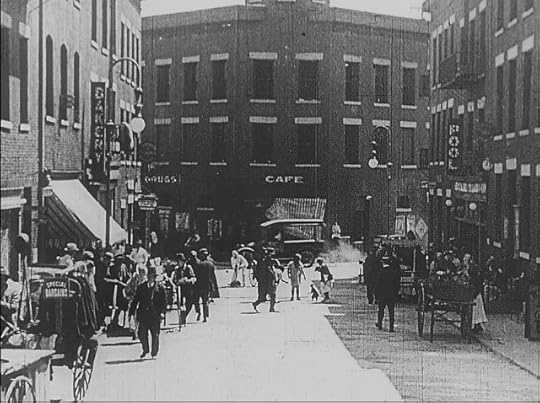
[image error]Broader views of the “Y” set, The Hoodlum at left, and Buster’s failed career as a street sweeper, in white uniform to the left of center, in Day Dreams. Note: the right side of the set also appears during Keaton’s Cops (1922) when Buster mistakenly purchases a horse and wagon for $5.00.


Next during Day Dreams Keaton plays an inept chorus line spear carrier who disrupts the show. Thrown from the theater while still dressed in Roman garb, Keaton attracts the attention of a suspicious cop. Looking closely, the posters on the theater wall behind Buster promote movies starring Norma and Constance Talmadge. Buster had married their sister Natalie Talmadge the prior year at producer Joe Schenck’s country home in Bayside, Long Island. Anita Loos was the bridesmaid, Constance was matron of honor, and Ward Crane, who later played the sheik in Keaton’s Sherlock Jr. (1924), was best man.
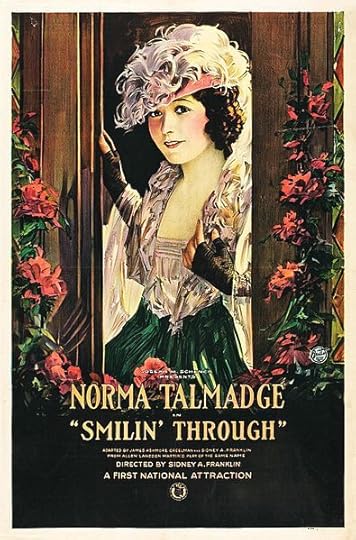


[image error]Norma starred as Kathleen in the 1922 romantic drama Smilin’ Through, a Norma Talmadge Production for First National. Keaton later paid another indirect tribute to Norma in his 1926 feature Battling Butler, when her Talmadge apartment building at 3278 Wilshire Boulevard, stood in for Alfred Butler’s mansion at the beginning of the film (left).


Constance starred as Josephine Gerson in the 1921 romantic comedy Woman’s Place, also featuring Kenneth Harlan, which was written by Anita Loos’s husband John Emerson.


Above, other views of the “Y” shaped Brunton backlot set. USC Digital Library here and here. Since these images are attributed to 1918, either much of the set was already built prior to Mary’s production, or the archive photo dates are only approximate.
Aerial views of the Brunton studio reveal where Keaton filmed other important scenes on the Brunton backlot, covered in prior posts, including the teeter-totter fence scene in Cops, and the swimming pool high dive in Hard Luck, and the waterfall rescue scene in Our Hospitality. Above, awaiting a future post, Natalie Talmadge’s southern hometown in Our Hospitality was also staged on the Brunton backlot (left box above – click to enlarge), while the waterfall set Buster built for Our Hospitality clearly appears in the right above box, next to Melrose Avenue. National Archives.
Please help support naming the Chaplin Keaton Lloyd alley in Hollywood by posting a review on Google Maps. Prototype alley sign design by noted Dutch graphic artist – Piet Schreuders. Download a 4-page brochure about the alley HERE.
Above, a comparable modern view east along Melrose of what is today the Paramount Studio (C) 2020 Microsoft.
February 1, 2020
Keaton’s Missing Scene and Cameraman Tricks
[image error]Early in The Cameraman (1928) neophyte newsreel photographer Buster Keaton submits his double-exposed mistake-filled audition movie footage to the M-G-M Newsreel General Offices in ‘New York,’ resulting in a complete disaster. At left, Buster watches in horror as his double-exposed fiasco plays out on screen.


To begin, as shown above, one brief double-exposed scene depicts a US battleship proudly steaming west up 7th Street in downtown Los Angeles towards the corner of Figueroa.

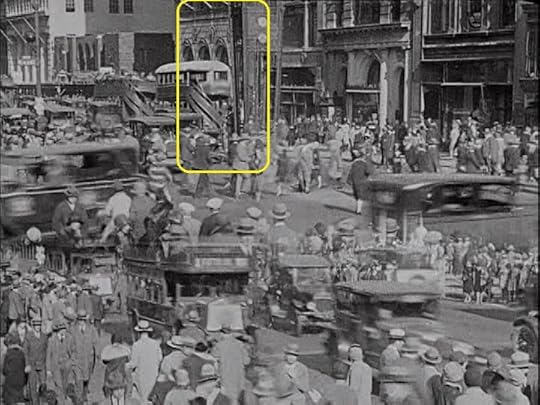
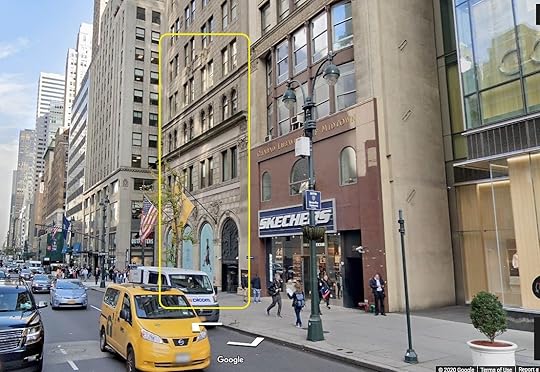
[image error]Another wild shot, upper right, was taken from the steps of the New York Public Library looking north towards the surviving Postal Life Building at the SE corner of 5th Avenue and 43rd Street (yellow box in each image). The demolition of the former Temple Emanu-El (1868-1927) synagogue once standing at the NE corner of 5th and 43rd, appears underway during the Keaton frame (it was demolished floor by floor, see detail at right, with blue stars marking the remaining height). Knowing the precise date when the temple was demolished (I don’t) would help establish whether Keaton’s crew took this shot during their brief New York visit, or whether doctored “stock” footage was used instead. USC Digital Library.
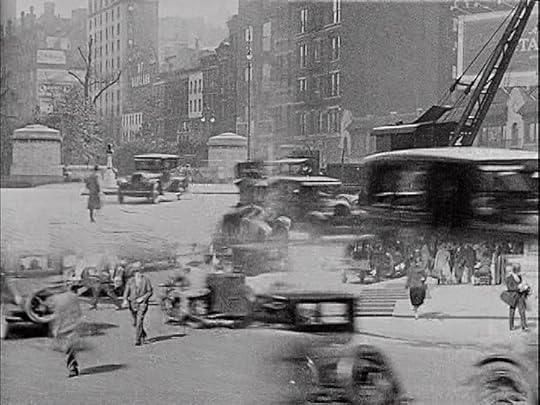
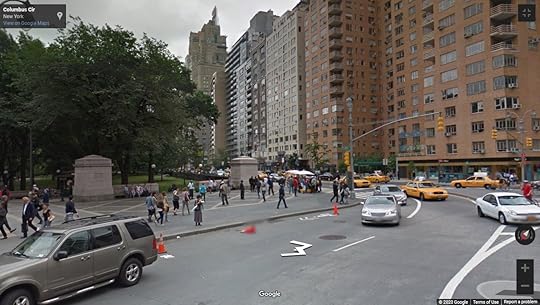
A third crazy shot looks SE from Columbus Circle in New York towards the entrance to Central Park.

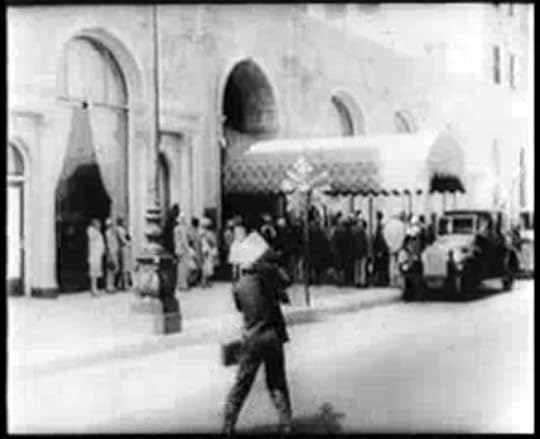

But remarkably, the disastrous footage contained a further joke. During George Pratt’s 1958 interview with Keaton, transcribed in Kevin W. Sweeney’s book Buster Keaton: Interviews, Buster describes rushing to a Park Avenue hotel to film a noted Admiral of the US Navy, and mistakenly filming the splendidly uniformed hotel doorman instead. Although Pratt and Keaton discuss how this “Admiral” footage is missing, for a time this scene appeared intact in a low-resolution file once available on the Internet Archive. I captured these frame grabs there in 2013. Here’s a Nitrateville chat group discussion about the missing footage.

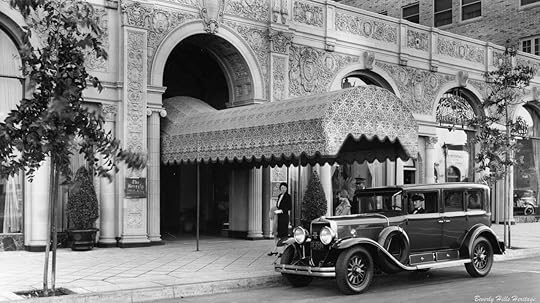
More remarkable, this apparently now missing scene was filmed at the recently opened Beverly Wilshire Hotel. Since the hotel reportedly opened in January 1928, its appearance with Buster could very well mark its screen debut as a filming location.
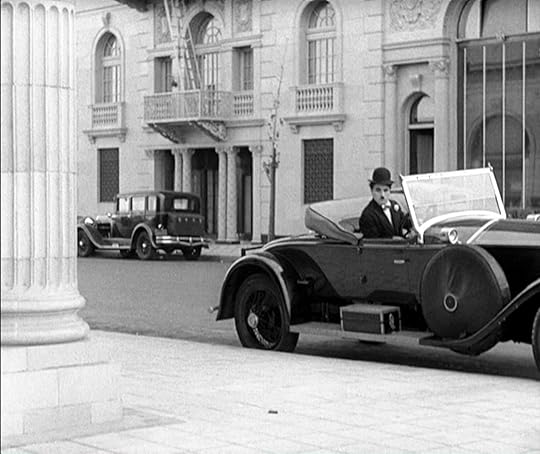
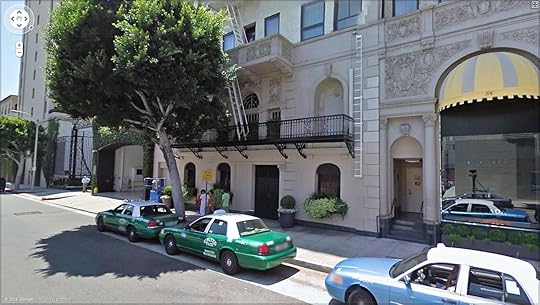
[image error]The side of the hotel on S. El Camino Drive appeared behind Chaplin during City Lights (1931) when Charlie spies a cigar butt on the sidewalk while driving his millionaire friend’s luxury car (see full post HERE). Charlie leaps from the car and grabs the butt before another bum can take it, leaving the bewildered bum behind as he drives off. Much later the hotel gained recognition as the movie setting for the Richard Gere/Julia Roberts 1990 prostitution comedy, I mean romantic comedy Pretty Woman, itself now 30 years old.
Please help support naming the Chaplin Keaton Lloyd alley in Hollywood by posting a review on Google Maps. Prototype alley sign design by noted Dutch graphic artist – Piet Schreuders. Download a 4-page brochure about the alley HERE.
January 18, 2020
Silent Comedy’s Crazy Corner
[image error]Quick – what are some essential elements for a silent comedy? A park bench? An angry cop? A banana peel? If you think about it, one absolutely essential geographic element is the humble street corner. It doesn’t matter what the corner looks like. It simply has to hide the cop lurking around the other side, so both the film comic and audience will be startled when he jumps into view. Other times a broad point of view reveals both sides of the corner, allowing the audience to anticipate the cop grabbing the unsuspecting comic, or showing two dashing figures on a collision course.
[image error]Perhaps the most frequently depicted cinematic corner is the NE corner of Motor and Woodbine in Palms, California. Located a mile or two from the former Hal Roach Studios in Culver City, the extant corner seems to appear in nearly every Roach production ever made, including early Harold Lloyd, Snub Pollard, and Charley Chase comedies, and numerous Our Gang films. Facing to the south and to the west, the corner remains fully illuminated nearly all day, perfect for filming.
[image error]Here above, from the early Our Gang talkie comedy Boxing Gloves (1929), Joe Cobb and Norman “Chubby” Chaney repeatedly bump into each other running around this blind corner, spilling the soft drinks they vainly keep purchasing as a treat for Jean Darling whom they hope to impress. This corner even appears in the debut Our Gang film. The same view today, appears at right.
But we’re going to study a far more eccentric corner, located just off the Plaza de Los Angeles in downtown. The narrow corner of Alameda Street and Los Angeles Street witnessed many of the silent comedy greats, and was used by Harold Lloyd at least three times.

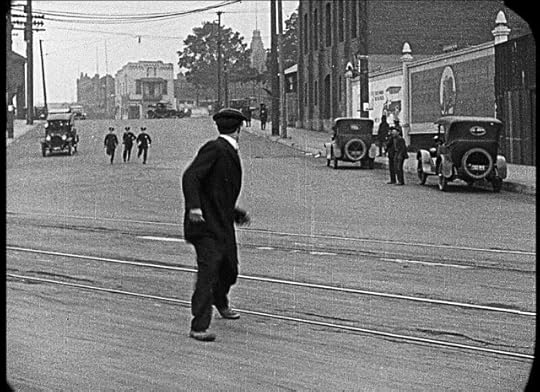
[image error]While Buster Keaton did not film at the corner per se, above here are matching views from Alameda looking down Los Angeles Street towards the Plaza, as seen in this vintage photo, above left (El Pueblo Monument Photo Collection), and matching view from Keaton’s The Goat (1921). The two story brick building to the right of Buster, the former electric yellow car Los Angeles Railway substation, still stands (see today view on Google Maps below). As I report in this prior post HERE, the fire station appearing behind Buster, facing the Plaza, survives today as a fire house museum, and appears incongruously as a Washington D.C. locale during the premiere episode of the Fox Network crime drama Bones, see matching views to the left.
The crazy corner stood just a few blocks away from the Bradbury Mansion – Rolin film studio on Court Hill, where Hal Roach and Harold Lloyd launched their film careers.


Above, a closer view of the narrow corner, and its appearance in the Harold Lloyd short That’s Him (1918), restored by archivist Dino Everett at USC, and released as a bonus feature to the Criterion Collection Blu-ray release of Lloyd’s The Kid Brother (1927). (I prepared a special visual essay for this release – Close to Home, read more HERE.)



Above, two more Harold Lloyd shorts filmed at this same corner, Off the Trolley (1919) upper right, and Hand to Mouth (1919) lower right. Given the number of early Lloyd films produced from the Bradbury Mansion studio nearby, now lost, he likely staged scenes from other movies here as well.
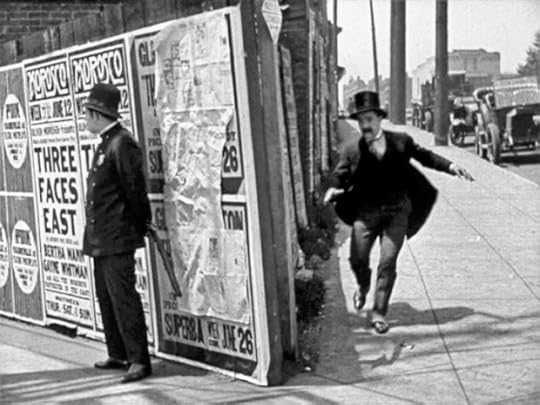


But this crazy corner was too good for the other comedians to pass up, so above left, appears the Roach-produced Snub Pollard short Fifteen Minutes (1921), part of Ben Model’s Undercrank Productions’ Found at Mostly Lost DVD release, while Larry Semon appears upper right in Frauds and Frenzies (1918), and Hank Mann appears lower right in The Janitor (1919).

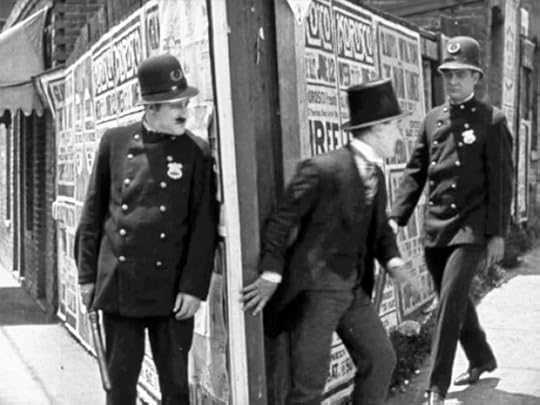

Above, more views with Snub Pollard at the crazy corner from Fifteen Minutes. Early in my research when I noticed different comedians using the same location, I felt it was a lucky coincidence. But instead it’s become increasingly clear that these locations were commonly known and shared within the small, tightly-knit film community.



Above left, Fifteen Minutes also has scenes filmed a block away from the crazy corner, looking south from Sanchez Alley down Arcadia towards Los Angeles Street, now lost to the freeway, matching scenes appearing in Buster Keaton’s Neighbors (1920) above center, and Cops (1922) above right.
[image error]
Los Angeles Street runs left-right below the Plaza, intersecting with sloped Alameda Street. The red circle marks the crazy corner, the blue circle the fire station museum, and the yellow circle marks the lost corner of Sanchez Alley.
Today the view south down Los Angeles Street from Alameda is subsumed by a landscaping plaza, shown below on Google Maps. The brick substation building is still standing to the right of the palm tree.
Please help support naming the Chaplin Keaton Lloyd alley in Hollywood by posting a review on Google maps. Prototype alley sign design by noted Dutch graphic artist – Piet Schreuders.
January 7, 2020
Happy “Roaring Twenties” New Year at Keaton’s Bungalow
If only he knew what was in store. Buster on the steps of his Grant Avenue bungalow, just outside of MGM
Happy New Year everyone! For some reason 2020 and its prior century silent-era counterpart resonate with me more so than 2019-1919 ever did. The Roaring Twenties are with us again. This widely viewed classic photo of Buster making his 1929 New Year’s Resolutions struck me when I realized it was likely filmed on the steps of the Grant Avenue bungalow Keaton rented just east of MGM. As described below, reprising a prior post, Buster had already staged numerous publicity photos (see below) on the front lawn of the bungalow he rented near the studio before moving to his “Keaton Kennel” dressing room on the MGM lot in 1930. Given the 1929 photo date, the matching visual clues in the background (window patterns, driveway), and the numerous similar photos conclusively proven to have been staged on Grant Avenue, I’m confident he posed for this photo there too.
When Buster Keaton joined MGM in 1928, he rented a bungalow near, but off site from, the MGM campus, infuriating studio head Louis B. Mayer, as Keaton was (one of) the only star(s) to rent space off of the lot. To rectify this, in 1930 or so MGM built Keaton a personal dressing room on the MGM lot, with living space and private kitchen, jokingly dubbed Keaton’s Kennel. My earlier post identifies exactly where the Kennel stood on the MGM lot, not far from the New York backlot set where Keaton filmed scenes from The Cameraman (1928) and Sidewalks of New York (1931).


But where was Keaton’s original bungalow off campus? He writes at page 214 of My Wonderful World of Slapstick that it was located where the Irving Thalberg Memorial Building now stands in Culver City, which places it on former Grant Avenue. Studying vintage maps and aerial photos, there were only a few candidate homes.


Somehow I came across these fun photos I had seen years before, Buster posing before a wide angle camera lens to create a series of distorted, attention-grabbing images. I then found a photo of him posing with director Edward Sedgwick, and realized that the background street in each image looked familiar.
[image error]
A 1924 view north of Grant Avenue next to the then Goldwyn Studio, before the funeral parlor on Grant and Madison (red box) was constructed. Keaton posed for all of the photos, including the 1929 Resolution photo at the top of this post, within the yellow box. Assuming the duplex to the right was symmetrical, the window pattern visible on the right (east) side of the duplex matches the window pattern appearing behind Buster’s Resolution photo, which shows the left (west) side. The driveway also matches the Resolution photo. HollywoodPhotographs.com
As confirmed by the Sanborn fire insurance maps and these aerial views, Keaton staged all four photos adjacent to MGM looking east down Grant Avenue towards the distinctive tiled roof of the Noice and Son funeral parlor at the corner of Madison and Grant.
[image error]
1933 view south of Grant Avenue, showing the funeral home (red) and lawn where Keaton posed (yellow).
A closer study shows Keaton posed for all four photos in front of the center home, a duplex actually, with the address 10132 – 10132-1/2 Grant Avenue. Given there were so few other candidate homes available, it seems most likely Keaton would only pose in front of the place he was actually renting.
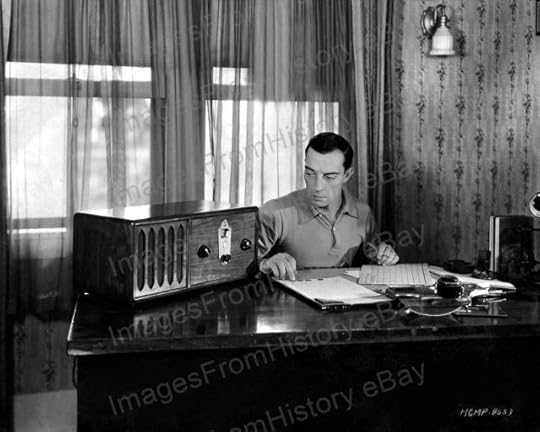

Given Keaton is wearing a similar short sleeve shirt, and the picture codes for the wide view shots and these radio poses all seem to begin with “MCMP,” I think it likely Buster took these above interior shots inside the same Grant Avenue bungalow, all as part of the same publicity shoot. Notice the plain curtains, fancy light fixture, and flowery wallpaper.
[image error]
Inside the Keaton Kennel
This photo of Buster (wearing long sleeves) with his sons and his father Joe was taken inside the Kennel on the MGM lot – the picture codes of Buster and his sons posing outside of the Kennel (4673, 4675) match the code for this interior view (4670), as do their clothes. The curtains here are not plain, and there appears to be no wallpaper. As such, I believe the above radio photos above were not taken inside the Kennel.
Below, a matching view east along what was once Grant Avenue, taken in front of the Thalberg Building entrance.
December 21, 2019
Buster Keaton at the Selig Studio “Prison”
[image error] [image error]I only recently became aware of the Selig Polyscope Studio, the first permanent studio built in Los Angeles that opened in 1909 two blocks north from where the Keystone Studio would later open. Focusing on the facility’s distinctive walls and turrets, I realized Charlie Chaplin filmed early scenes here beside the studio, as detailed in this recent Charlie at Selig post, including the movie-within-a-movie scene Charlie and Mabel Normand watch during Tillie’s Punctured Romance (1914) featuring the Selig Studio’s corner gated entrance (above right).



Once this “new” Selig locale found its place in the mosaic of silent movie geography, the transitive theory of film locations kicked in. The Selig photos confirmed Chaplin filmed here, and in turn the Chaplin movie clues confirmed the next discovery – Buster Keaton filmed his prison gate scene from Convict 13 (1920) at the Selig Studio corner as well.
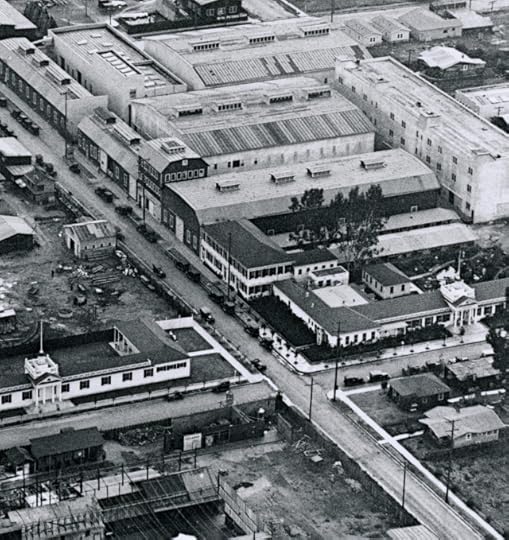

As I explain in my book Silent Echoes, Keaton filmed his prison comedy Convict 13 primarily at a large outdoor prison set on the backlot Romaine/Cahuenga corner of his small studio (notice the two guard towers, one on the ground, in this 1921 aerial view HollywoodPhotographs.com). When Buster stands on the prison gallows, you can see various Metro Studio buildings further south along Cahuenga behind him.
[image error]
A “real” non-prison gate standing in for a prison – Hank Mann in The Janitor (1919); Charlie Chaplin in Police (1916); Stan Laurel in Detained (1924). See Four Jails post.
[image error]Despite Buster’s elaborate studio set, I long suspected the corner gate appearing in Convict 13 was actually “real.” First, I knew genuine gates portrayed prison gates in other silent comedies (for example above, the frequently used Los Angeles County Psychopathic Hospital gate explained in my Four Jails post). Keaton’s gate seemed both too detailed, and yet not sufficiently intimidating, to be a set built to look like a prison. I also knew the gate was not filmed at Keaton’s studio, as the steep uphill street at back doesn’t match the flat studio site. So once I became aware of the Selig gate, the pieces fell into place.
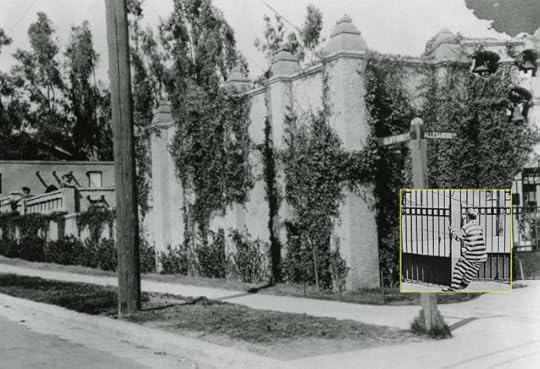


Click to enlarge – the proportions and details all match. Keaton’s corner gate at Clifford St. and Glendale Blvd. stands within a curved arch, with staggered rectangular elements filling the curve, matching the Selig gate photo, Clifford St. sloping uphill across the street at back, and this close-up from Tillie’s Punctured Romance.




While this must wait for future post, I’ll briefly share that opening scenes from One Week (1920) and Convict 13 were filmed on Los Feliz. Click to enlarge – the two left images look west towards the public stairway where Los Feliz turns south – the two right images look east at the corner of Los Feliz and Serrano.
Also awaiting a future post, most Convict 13 golf scenes were filmed at the newly opened California Country Club near Culver City.
A final view of the Selig Studio, later home to Clara Kimball Young – Tommy Dangcil. Notice Buster’s “prison gate” to the left. Below, the corner of Clifford and Glendale, where the Selig Studio entrance gate once stood.
Please help support naming the Chaplin Keaton Lloyd alley by posting a review on Google Maps. Prototype sign design – Piet Schreuders. Download a brochure HERE.
December 4, 2019
Buster Keaton’s Scarecrow Adobe
[image error]I’m delighted to host guest blogger Jeffrey Castel de Oro’s amazing post regarding the early California history appearing in Buster Keaton’s The Scarecrow. A friend for 20 years, Jeff has contributed many significant locations and photographs to all of my books, including at left two of my favorite of his discoveries, both scenes from Keaton’s Cops – the triangle building that proved to be the former USC College of Dentistry Building, and a scene in the downtown Civic Center on long lost New High Street, in the shadow of the former Hall of Records Building and County Court House. Take it away – Jeff.
[image error]
A true adobe – looking SE towards the Baldwin Hills.
In the 1920 short film The Scarecrow Buster Keaton’s farmhand character, on the run from a dog he has mistakenly assumed to be rabid, is pursued to a small house made of adobe bricks. After a frantic chase diving in and out the doors and windows Buster climbs a ladder to escape. The dog (portrayed by Luke, who was owned by Buster’s good friend Roscoe Arbuckle) amazingly also climbs the ladder, and the chase continues perilously atop the crumbling walls of the roofless structure.



Due to its scale, density and realistic level of detail, it appears that the adobe depicted in The Scarecrow was an actual found location rather than a set specifically constructed for the scene. In the 1920s there were still remnants of adobe structures on existing farmland, dating back to large land grants given by the Mexican government to encourage settlement of its territory and the use of the land as ranches (ranchos) for raising cattle and sheep. After California became a state in 1850, a series of setbacks beset the rancheros, including a decline in cattle prices, floods and drought. Forced to take out loans, and often unable to read the contracts they signed due to a lack of formal education, grantees began to gradually lose their land.
This 1888 map illustrates a period of transition, after the arrival of the railroad began to dramatically increase the population of Southern California and the still-recognizable ranchos were being divided into smaller and smaller tracts.
[image error]Having some familiarity with areas in which Buster Keaton likely filmed, I focused my search on the former rancho areas located on the west side of Los Angeles. There are a few clues to how the house must have looked. The joist holes above the door and windows indicate a porch roof that pitched downward on either end. Additional holes along the base indicate a front porch.
[image error]This photo entitled “Adobe on the road to Venice” taken by Los Angeles historian and amateur photographer George W. Hazard is currently housed at the Huntington Library. It was recently made available online as part of the Ernest Marquez Collection. The Huntington estimates that the photograph was taken between 1890 and 1908, the years that George W. Hazard was active as a photographer. Enhancing the porch area reveals structural details matching those suggested by the film frame, most notably the porch roof pitched downward at each end.


Also visible in the film frame are numerous large white rocks embedded in the adobe bricks. By carefully examining the location of these rocks among the pattern of the bricks, comparing them to a closeup of the George Hazard photo, and accounting for some years of weathering, it is possible to definitively match the two structures.
The inscription of the Hazard photo “Adobe on the road to Venice” provides a starting point to locate the house. At the time the photo was taken (as late as 1908) there were very few roads leading directly to Venice. The only prominent route to Venice visible on this 1909 travel map is Washington St. (now Blvd.). David Rumsey Map Collection.

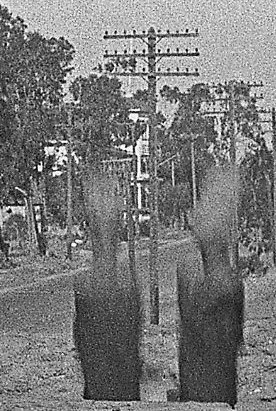
But where exactly on the road to Venice was the adobe located? Just above Buster’s shoulder in this movie frame, where the road bends to the right, can be glimpsed a tall white structure amongst the trees. It features a tower topped with a flagpole or spire, a triangular roof, and a pattern of large windows or openings just below the roof. A full length view of the three-story structure appears between Buster’s legs as he falls over backwards (at the time nearby Culver City had only two-story buildings). Notice too the prominent “MJB Coffee – Why?” coffee pot billboard in the background, a curious advertising campaign that helped to solve John’s prior post about a small Japanese enclave living in Hollywood.


The original La Ballona School (above) located along the bend of Washington Blvd. features details which match the building in the movie frame precisely (see comparison inset). LAPL. It stood from 1865 to 1927 and has been rebuilt twice. A modern elementary school still stands at the location, marked as Historic Site #10 by the Culver City Historical Society in 2001.
This 1921 aerial view looking west across Culver City towards the ocean features the Hal Roach Studios and adjoining Henry Lehrman Studios (yellow oval), the Thomas H. Ince Studios (red oval), and the Goldwyn Studios (green oval), which would become MGM in 1924. Washington Blvd. runs diagonally through the image past the four studios before zig-zagging on its way towards Venice, its canals visible in the upper right corner as a set of 4 parallel vertical lines near the beach (blue oval). Marc Wanamaker – Bison Archives.


La Ballona School (yellow oval) stood to the right (north) of the bend of Washington Blvd. pictured above in this 1921 view. By zooming in on the area surrounding this bend we can see the likely location of the adobe, perhaps indicated by a lone round tree on the south side of the street (red arrow). Since the adobe stood close to the road, it may have already been demolished in this 1921 view.
[image error]A closer and clearer view taken in 1925 reveals the likely site for the adobe (red oval) apparently now demolished, related to the school at the bend in the road (yellow oval). Marc Wanamaker – Bison Archives. Just below it stands the Plantation Café (pink oval). Built in 1922 by a former vaudevillian and restaurateur named Mike Lyman and his partner V. B. Clark., it would later be purchased by Roscoe Arbuckle in 1928, the same year Buster Keaton would join MGM.
A final view shows the area as it appeared in 1927. Marc Wanamaker – Bison Archives. The adobe is apparently gone, the farms further subdivided with numerous houses visible. The La Ballona School (orange oval) has been rebuilt, while the Plantation Café (purple oval) remains standing across the street. Nearby can be seen the Culver City Rollerdrome (light blue circle), a large indoor skating arena also visible in Laurel and Hardy’s County Hospital (1932). The Rollerdrome site will soon be marked as Historic Site #14 by the Culver City Historical Society.
[image error]This view from Google Earth looking NE shows the contemporary La Ballona Elementary School at the bend of Washington Blvd. Across the street at the former location of the Plantation Café now stands a large NFL Network facility. The location of the adobe was approximately the patch of green grass (yellow circle) near 4018 Tilden Avenue.
[image error]A former visual effects artist, Jeffrey Castel de Oro is an amateur historian, genealogist, and hopeful professional archivist, who has been a Buster Keaton fan since first seeing Kevin Brownlow’s documentary A Hard Act to Follow on PBS in 1987. You can follow Jeff on Twitter @jeffcdo. Thank you Jeff for sharing your amazing discovery – yet another example of our common history preserved in the background of silent film.
November 20, 2019
Silent Hollywood’s Japanese Enclave
[image error]The great silent film comedians Charlie Chaplin, Buster Keaton, and Harold Lloyd filmed more frequently on the 1600 block of Cahuenga south of Hollywood Boulevard than at any other street in town. Keaton alone filmed scenes for eight different movies on this block. Popular with the studios as a filming location, I’ve
[image error]
View south – the 1500 block of Cahuenga from Selma to Sunset, where Cahuenga once ended – LAPL
identified over 40 different silent movies staged here so far. Since most silent films are now lost, it’s likely many other productions were filmed here as well. You can read more about this historic Hollywood street HERE and HERE.
But the 1500 block of Cahuenga, between Selma and Sunset one block further south, tells another compelling story. While this street has also appeared in many silent movies, the block provides mute testimony to Japanese-American history in Los Angeles preceding World War II.


It all began with Buster Keaton’s 1921 comedy short The Goat. While fleeing the police Buster runs past a cop beside a grocery store awning that reads “JAPANESE RICE AND TEA.” One of my earliest discoveries, I found this simply by noticing the confusing and once ubiquitous “MJB Coffee – Why?” advertisement appearing in this matching vintage photo looking south down Cahuenga towards Selma. The photo reveals the grocer’s name “Toribuchi,” confirmed by vintage phone books as the Toribuchi Grocery at 1546 Cahuenga.


Originally a small church, the Toribuchi Grocery building previously served as Hollywood’s first fire station, Hose Co. No. 7. LAFire.com. The building was converted to a grocery when the new joint fire/police station opened up the street at 1625-1629 Cahuenga in 1913. I noticed the Japanese rice and tea sign with interest, but didn’t give it much thought until I recently discovered the store also appears in Colleen Moore’s Her Bridal Nightmare (1920)(above right), filmed extensively on Cahuenga.
[image error]
Click to enlarge – looking west in 1919 at the 1500 block of Cahuenga between Sunset (left, where the street once ended) and Selma (right), showing some of the Japanese establishments once located there. The map below identifies several small “Japanese Lodgings” near the word “Lodging” above. HollywoodPhotographs.com
Then, while searching through the 1919 Sanborn Fire Insurance Maps for the 1500 block of Cahuenga, I noticed something unexpected. The map identified a Japanese boarding house, a Japanese laundry, and even a Japanese school on this then sparsely developed street. I already knew the Toribuchi Grocery was located here, and with a little digging it became apparent the 1500 block of Cahuenga between Selma and Sunset was at one time a Japanese enclave, a single-block Hollywood version of Japantown.
Here below is a roster of Japanese-associated names for this single block, keyed to their address and the year such entry appeared in the LA city directories. Mr. Toribuchi relocated his grocery sometime between 1920 and 1927. Click to enlarge each map.
[image error]CAHUENGA – from Selma to Sunset
1546 E. H. Toribuchi grocer (1920)
1533 Kitro Suietoni (1920)
1531 S. Tatsukawa (1917)
1529 G. Yoshihashi laundry (1920)
1527 Toribuchi Grocery (1927)
1525 Y. Hisatowi (1927)
1519 Joe Nishigima (1927)
1518 Hollywood Japanese Day Work, M. Suzuki (1917); Eto Boarding House (1920)
1517½ Japanese School
1517 K. Ashina baths (1918) S. Dohara (1920)
1516 Sunrise General Merchandise J.M. Hachiya mgr (1920)
1515 Senzo Imai grocer (1920)
[image error]SELMA – from East to West crossing Cahuenga
6374 Japanese Church of Hollywood (1923)
6378 Frank Aiso (1927)
6410 Geo. Yaguchi gardener (1916)
6442 G.J. Matsumoto (1920)
Imagine – at a time when few Japanese resided anywhere in LA, and Hollywood was still sparsely settled, there was once a small enclave on the 1500 block of Cahuenga, directly south from where dozens of silent movies were filmed. Yet there appears to be no record of this history aside from these maps and their related entries in the city directories. How did this enclave form? How did they find each other? (The 1600 block also has some Japanese listings, but no references on the maps.)
While the development of Japanese communities such as Little Tokyo in downtown and in Boyle Heights is well documented, perhaps someday this story will be fully revealed. There are many resources to learn more about Japanese history in Los Angeles, including Densho: The Japanese American Legacy Project, the Japanese American National Museum, and the Japanese American Cultural & Community Center. Brian Niiya, Content Director for Densho, shared this oral history of James Ito, born in 1914, recalling his family’s fruit and vegetable store on this block of Cahuenga.

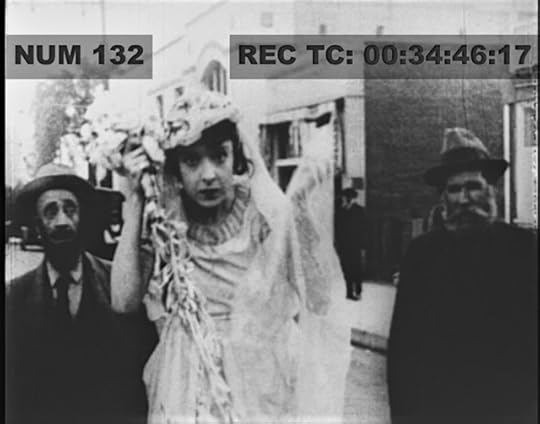

Two closing views looking south at Cahuenga addresses, with Colleen Moore in Her Bridal Nightmare and Mr. Hachiya’s Sunrise store at 1516 (left), and Mr. Imai’s one story grocery at 1515 (center of center), with a modern view of 1515 (right), now a cannabis shop.
Looking south down Cahuenga towards Sunset, where Cahuenga originally ended, continuing south along Ivar instead.



